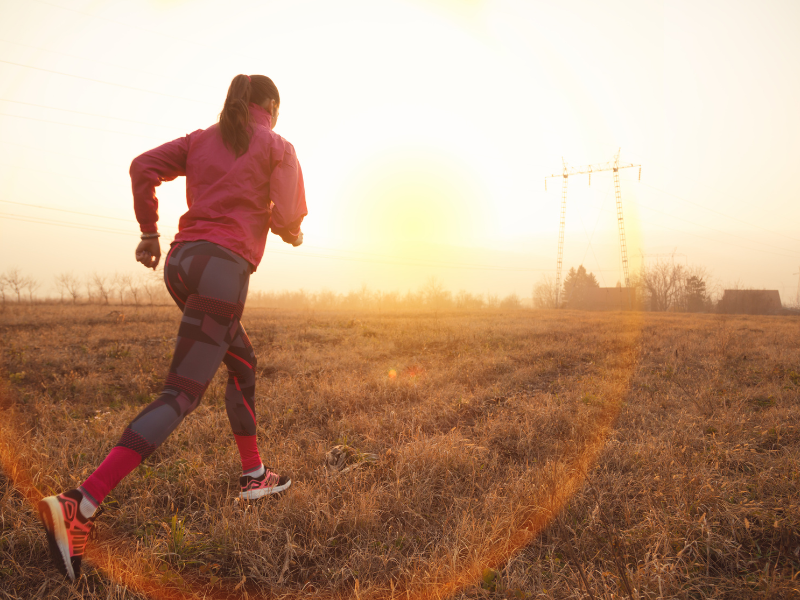[ad_1]
Work Out While Breastfeeding – The 6 Most Important Things to Know
Below are the 6 most important things to know when you are willing to work out while breastfeeding.
1. Your calorie demands will be higher.
Italian research found that breastfeeding, on average, burns an additional 450-500 kcal a day. When you also add on exercise, those daily calorie demands increase further. This has always been a plus for me. Who wouldn’t love the idea of eating more food throughout the day?
Medical news found that how many calories you will burn while exercising depends on several factors, such as weight, exercise intensity, duration, and individual muscle mass. You can check calorie-burning calculators online to estimate how much you burn during your workouts.
Higher-intensity workouts burn more calories. For example, running will burn more than walking the same distance. On the other hand, lower-impact exercises such as swimming and cycling will burn fewer calories at the same time as higher-intensity workouts.
After having a baby, your mind might be on weight loss. Working out and breastfeeding are great ways to start the weight loss journey, but you must look after yourself and your baby. Not eating enough can impact the quantity of breast milk and leave you low on energy.
If you want to work out while breastfeeding to lose weight, the best approach might be to lose it gradually- for instance, lose 4-5 pounds a month.
2. You will need to drink more water.

Breastfeeding increases a woman’s demand for water. The Institute of Medicine found that a breastfeeding mother needs 3.3 liters daily, about 14 cups daily. This statistic does NOT include increased demand due to exercise.
Water is absorbed in the body from drinking water and the food we eat. Therefore, foods high in water content, such as fruit, are a great way to increase your water consumption.
A Chinese study found that for every 100 kcal of energy used, a breastfeeding mom needs an additional 54 mL of water, about a quarter of a cup of water. Therefore, women who work out while breastfeeding will need to drink a lot of water.
The best way to ensure you are drinking enough water is to always have water on you. Bring a bottle with you to the gym and in the car when out for the day, and drink a cup of water first thing in the morning.
3. Best to plan your workout around feedings.
Breastfeed or Bump immediately before working out.
You will want to work out soon after feeding your baby or pumping. The longer you go after emptying your breasts, the more full your breasts will feel. Exercising will become more uncomfortable the fuller you are.
Breastfeeding is more effective than pumping. If you have the option, always breastfeed. A study done with 122 6-day-old babies found that a breastfed infant took in 50% of the total volume of milk available in the breast in the first 2 minutes of breastfeeding and 80% in 4 minutes.
In contrast, a study in Australia found that a pumping session between 8 and 15 minutes removes between 50-75% of available milk in a beast. Therefore, you will feel better working out if you breastfeed over-pumping, given a choice.
Working out during the afternoon or night will be more comfortable.
The milk-producing hormone prolactin is highest (around 2-5 am) and lowest in the afternoon to early evening, the department of biochemistry in western Australia found. This means your breasts produce more milk in the morning than later in the day. So working out later in the day when your milk production is lowest will be more enjoyable.
Personally, I have experienced several clogged ducts as a result of working out with full breasts. Clogged ducts are never fun and take some time to return to normal.
4. You will need a more supportive bra.

After having your baby, your body changes, and one of the noticeable changes is the increase in breast size. You will want to ensure your workout bra fits appropriately with increased breast size.
The too-tight bra can lead to chafing and an increased risk of a clogged duct forming. It will also be uncomfortable. On the other hand, if your bra is too loose, your breasts will bounce around, causing pain.
Clogged ducts can occur from the pressure on your breast from a bra that is too tight or from being compressed too long. You will want to minimize the amount of time in your sports bra. Sports bras are restrictive; the longer you wear them, the more compressed your breast will be.
Put on your sports bra right before a workout and change out of it immediately following your workout. This will minimize the amount of time your breasts will be compressed.
My husband and I commonly run in a jogging stroller with our baby and toddler. The run often ended at a playpark to let our toddler run around. I have learned to bring a regular bra and switch into it immediately following the run. This is crucial for me to feel comfortable and to lessen the risk of a clogged duct.
5. Exercise helps improve your mental health.
Having a baby takes its toll on a woman. How a female body changes to grow and give life to a baby is genuinely spectacular. However, all those changes in your body can make you feel low.
Consider breastfeeding a full-time job in itself, and no wonder new moms are worn out mentally and physically.
A full-time 40-hour work week with three weeks of vacation equates to 1,960 hours of work a year. If you breastfeed your baby for an entire year is estimated to be 1,800 hours.
To help reduce the stress on your mental health, you can exercise regularly. During the postnatal period, women who exercise report better overall mental health than those who don’t, according to a study found in the Maternal and Child Health Journal.
Exercise in all different forms can help improve your mental health. For one who likes group exercise, a 45-minute exercise session can reduce anxiety levels, according to a study at the Department of Kinesiology at the University of Western Ontario.
Working out can lead to a sense of accomplishment. The American Psychologist Association recommends exercise to help alleviate depression symptoms. Some days it will only take one win, like the accomplishment of fitting in a workout, to lift your spirits and turn your day around.
The best thing a mom can do for herself after having a baby is to look after herself. After being cleared by the doctor, a regular exercise is a form of care with many positive mental health benefits.
6. Adjust your expectations.

It is excellent that you want to work out while breastfeeding. But be aware that you won’t immediately be able to start back to what your exercise regime was before you had kids.
You will need to slowly and gradually increase the intensity and duration until you get to your pre-baby levels. Remember to be kind to yourself; your body has been through a lot and is still providing for your baby. However, the good news is that exercise is a great tool to help moms stay healthy both mentally and physically and to aid in losing weight.
Things will come up which will make working out difficult; clogged ducts, mastitis, sickness, and lack of sleep. Allow for a flexible workout schedule; otherwise, you might face disappointment and frustration.
The year before I had my first child, I ran a marathon, 26.2 miles, at an 8 min a mile pace. So after having my three kids in four years, I was happy to be able to run 3.2 miles at a 9 min a mile pace.
Will My Milk Be Sour-Tasting After Working Out?
It is true that after a strenuous workout, your body produces more lactic acid. The lactic acid buildup in your body can enter your breastmilk, leaving a bitter taste. This usually is true for up to 90 minutes following intensive workouts, according to a study done at the Department of Cellular and Molecular Physiology. Some babies will not mind the taste change, while others could reject the feeding.
For a moderate or lower level activity, the breast milk taste should not change. The only potential change in flavor comes from feeding your baby right after a workout when you haven’t cooled down yet. In this case, the breast milk will pick up a salty taste from your sweat.
My babies have never minded my breast milk taste immediately following a workout. I would describe most of my workouts as moderate intensity, usually a long run, and I have never noticed a change in my baby’s nursing afterward.
Best Workouts You Can Do With Your Baby

Finding time away from your baby can be a challenge. Luckily, there are plenty of exercises that you can do and still be with your baby. Some of my favorite workouts I do while still with my baby or toddler are:
● Running with a jogging stroller
● Cycling with a child carrier (baby should be able to support their head, around 1-year-old)
● Hiking with a soft structured carrier or hiking backpack (6 months + babies)
● Workout video at home while baby plays or naps.
To Sum It Up: Work Out While Breastfeeding
As we have discussed, work out while breastfeeding is possible. You should always slowly add exercise to your routine and listen to your body’s needs as you do so. It will be necessary to take a few precautions when working out while breastfeeding, such as being mindful of nutrition and hydration, allowing for extra rest time, wearing the right clothes and supportive bras, expressing milk before exercising if need be, paying attention to the intensity level of your workout, and avoiding extreme core work. Combining these ideas with the advice discussed in this blog post allows you to do physical activity while breastfeeding safely and enjoyably. Working out while nursing has a lot of physical benefits and can also make you feel empowered as a mother!
Disclaimer: Please take note that I’m not a Doctor or Nutritionist. All the information in this article is published in good faith and for general information purposes only. It is not medical/health advice or a substitute for such advice.
If you enjoyed this article, please consider sharing it with others!
You can also stay in the loop and follow us on Facebook, Instagram, or Pinterest.
You may also be interested in reading the following articles:
25 Healthy Snack Ideas for Toddlers That Will Keep Them Happy
Babyproofing Checklist: 6 Steps to Quickly Childproof Your Home
5 Best Word Games to Play to Make Learning Fun
5 Steps to Choose The Best Eco-Friendly Diaper
Britax Advocate vs Boulevard vs Marathon – Which One Is The Best?
Similac Advance vs Pro Advance: All Differences Explained
25 Best Practical Gift Ideas For New Dads (for Every Budget)
21 Diaper Bag Essentials: What to Pack in a Diaper Bag?
Air Purifier vs Humidifier for Baby: All Differences Explained
[ad_2]
Source link



